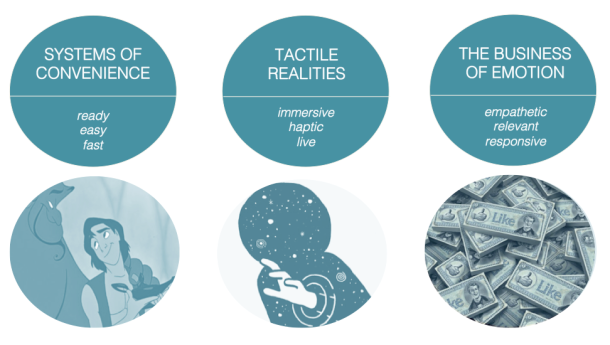In Product Innovation, we’re endlessly curious about the future and how it can inform what to make a start on today. To that end, we kicked off the year exploring 3 themes we have seen emerge across the industry. Here is what we’ve discovered when we took stock to make sense of what’s happening around us, and what it can tell us about the immediate future.

- Systems of Convenience
Collapsing distances & humanising interactions in between wanting and getting.
The notion of technology providing people with everything they want, when they want it, is obviously not new news. However, the way this theme is currently playing out is worth exploring in more detail, as there has been a shift away from products and services delivering convenience in isolation, and towards all-encompassing platforms geared to ensure everything is not just available, but ready – before, or just as, a need arises.
Behaviours & Implications
Last year, we identified a series of emerging behaviours and grouped them under the banner of ‘nowism’ – acting on needs only as they arise (which, over time, come with using on demand services habitually), valuing time more than ever before & spending on services that can help save or protect it.
So-called choice paralysis from trawling and comparing endless options for everything one might need or want has increased a desire for abdicating these time consuming processes to someone or something else.
In turn, with a desire to spend their time on things that are meaningful or enjoyable, rather than on searching, planning, and grappling with abundance, people will continue to seek out products and services that promise effortless decision making, immediate fulfillment and access, and improved relevance.
Categories of Interest
We’ve been watching the emergence and rise of the AI-powered Virtual PA’s as of late – omnipresent systems that simply listen and watch in order to know when to act, collectively aiming higher than simply being useful, and wanting to become life partners to their users. The Internet’s giants have made some big bets in this space, spanning both hard- and software solutions – Facebook with M, slowly making its way into the Messenger platform, and Amazon, by way of Echo / Alexa. Single-purpose services in productivity space, such as X.ai (a scheduling assistant, who presents itself as Amy) and Charlie (feeding you knowledge about topics and people the moment they are needed, amongst others) have piqued interest too, providing their services simply by listening and watching your emails and diaries.
In order to play to their audience’s growing desire for immediacy and simplicity, several eCommerce and CRM technologies are seeking to crunch any customer journey that entails consulting multiple destinations and platforms. We will shortly witness what Facebook Messenger has in store for business, as it evolves to accommodate product discovery, transactions, and customer care, all via the medium and of chat. Furthermore, it remains to be seen what the future holds for Amazon’s Firefly (or its challengers)- if all it takes is a simple photo to trigger the fulfillment process, shopping the immediate environment could be set to become habitual.
Finally, a new wave of On Demand Services are gearing up to collapse the path to purchase even further whilst promising to fulfill faster than ever before. The service Magic is at your beckon call for anything your heart desires via a simple text (which are then fulfilled in the real world, and can span pizza orders to getting trained to ‘look like Jason Borne’), whilst Uber (via Uber Rush) and Amazon (via Prime Now) are both aiming to provide within-the-hour fulfillment – tomorrow, clearly, was yesterday and the promise of crunching time, in the age of impatience, a sound revenue-driving opportunity.
At the heart of most of these cross-category examples, the recurring theme of humanising the exchange between service and customer prevails. After all, as people abdicate more and more responsibilities and decisions to machines, they must be trusted. Injecting the relationship with humanity (in most instances, through voice- or text-based conversation) is key to building this trust.
In summary, we’re witnessing a shift towards converging and hosting any customer journey on singular platforms, characterised by stripped-down or invisible interfaces, conversational interaction with service providers, and immediate access to that which has been sought out to gratify (usually promising the highest quality / value for money available).
———
2) Tactile Realities
Enriching relationships and experiences by layering sensory stimulus on top of ‘cold’, digital interactions.
Over the last years, we’ve seen communications services embrace emotion (emoji, stickers), entertainment become more exhilarating (both, in cinemas and at home), cultural institutions, like art and theatre, embrace the rules of the blockbuster, and meals in restaurants served with a side of theatrics. All round, experiences are heightened and now, technology is following suit.
Behaviours and Implications
A notable driver of Tactile Realities is people’s unwavering appetite for excitement – if an experience doesn’t capture, move or thrill them, it’s not deemed worthwhile, let alone social currency. Creating immersive experiences that hold focus and heighten senses are therefore essential to engage.
Secondly, people have a broad, nuanced range of emotions and reactions they desire to express, yet this is vastly underserved by glass screens and ‘like’ buttons. Adding to existing modes of expression through the use of haptics for example, will engage more than just visual senses around more complex expressions of emotion.
Finally, as people continue to live vicariously through others across various social platforms, shared experiences are exploring and playing with real time, thereby enriching the relationship between sharer and spectator.
Categories of Interest
The obvious industries that will breakout under this theme this year are gaming and entertainment, mainly through accessible VR products and experiences. Hot on the heels of the headset are its mobile equivalents, such as Figment VR, suggesting its future will be on demand, wherever, whenever. Network innovations or data plans must take note and follow suit, fast.
In the wearables category, haptics are increasingly making use of a previously untapped resource: our skin. They can help people distinguish between different forms of communication (like Apple Watch, which uses different sensations to convey alerts from different platforms). Furthermore, new languages are being investigated, where taps on the skin are designed to communicate words and not just alerts – most notably explored by Google’s Buzzwear research project. And in combination with biometric data as a trigger, haptics can also serve as prompts for action – in the case of TouchSense, these could entail relieving stress or promoting movement.
Finally, for social products and platforms that are increasingly moving towards ‘live’ (e.g. Meerkat, Periscope and Facebook Livestream), the next challenge will be to facilitate sharing live experiences in immersive ways, beyond streams on screens. This is a passionate talking point for Mark Zuckerberg (and arguably, a driving force of his portfolio strategy as of late), who images a future in which “you’ll be able to think of something and your friends will immediately be able to experience it too”. MIT’s projects SHAIR (headsets facilitating immersive content sharing as an elevated form of social networking) and Holosuite (3D telepresence) have already made a start on making this vision tangible.
In summary, in addition to bringing greater pleasure to their interaction with the technology itself, products that create ‘tactile realities’ aim to bring people closer to the things and to the people that matter to them.
———
3) The Business of Emotion
Better targeting & application through emotional intelligence
The process of harnessing and combining data to make it ‘big’ in order to target efficiently is about to undergo substantial change based on the very simple truth that people are more complex than their habits, preferences and movements. In reality, all activities in life are overlaid by one crucial dimension that most technologies (especially ones geared to track) have failed to embrace until now: emotion.
Behaviours and Implications
Future data-related efforts, regardless of purpose, should consider complementing tracking habits / movements / consumption with listening, reading and watching emotions – only then can experiences be created that are truly empathetic and in turn, as relevant as possible.
It’s also worth remembering that people are very particular about their tastes, especially in the context of their mood. Targeting them as individuals, regardless of how niche their preferences get, is more likely to hold their attention, be relevant and even gain trust, than if they are treated based solely on demographics.
Furthermore, letting emotional intelligence drive when to surface what information (regardless of whether this is a news story, a promotion, a notification for something to watch), will ensure its usefulness in whole new ways.
Categories of Interest
There are several industries and categories that will greatly benefit from embracing emotional intelligence by way of emotional response data. Wearables are starting to extend themselves into complementing activity tracking with mood analysis – Spire and Feel for example are geared to detect stress and recommend antidotes in real time.
The marketing industry has developed an interest in using emotion recognition technology to better understand content consumption – and with MIT’s spin off Affectiva gaining traction amongst content providers and Apple’s recent purchase of Emotient (who promise to ‘[transform] audience measurement & interaction’), it can be assumed that this interest will scale fast and ultimately, as data will start to drive creativity, shape how and what people will end up watching in the future.
Finally, emotional intelligence is making its way into the IoT space too – adhering to the theory that action data is only half the picture, products are baking in facial tracking and analytics into objects with screens and surfaces (e.g. mirrors, VPA systems, home robots, etc). Alongside the ability to converse like a human (as cited earlier), emotional intelligence, and the empathy it brings to interactions between machine and human, increases the chances of building much-needed trust between them.
In summary, tuning into emotions to create empathetic experiences promises greater relevance and usefulness, as well as a new way of making products indispensable and trusted.
—
Throughout the exploration of these themes it became evident that one way of predicting the future of emerging trends and behaviours is to play with the technologies that are both drivers and by-products of change.
Imagine, if you will, the convergence of emotionally intelligent wearables and in-home objects into an ecosystem that can gather a full picture of how people feel at any given moment. The possibilities this presents for tailoring and targeting content, managing lifestyles and cultivating wellbeing, are vast.
If (or rather, let’s face it, once) Oculus merges with Facebook’s Livestream platform, or any new mobile VR player merges with a service like Periscope, sharing has enormous potential to become mutually rewarding experiences, rather than just about showing off / lusting after.
And once the Virtual PA’s are hooked up to our emotions, and into delivery platforms that promise immediacy – could this spell the end of choice?
Either way, this exercise taught us that when you’re trying to predict the ‘next’, don’t hesitate to play & converge within the ‘now’, without letting category walls or questions of feasibility get in the way.









